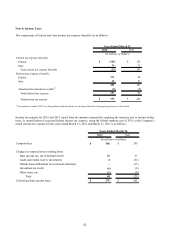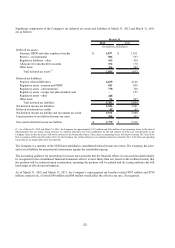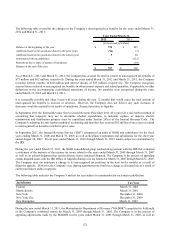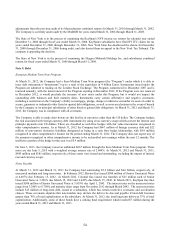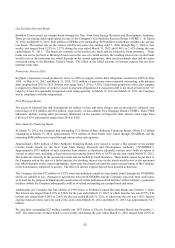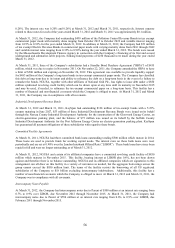National Grid 2012 Annual Report Download - page 62
Download and view the complete annual report
Please find page 62 of the 2012 National Grid annual report below. You can navigate through the pages in the report by either clicking on the pages listed below, or by using the keyword search tool below to find specific information within the annual report.61
of KeySpan. In February 2010, the United States Department of Justice (“DOJ”) filed a civil complaint, joint stipulation
and proposed final judgment under which the DOJ and KeySpan agreed that KeySpan will pay $12 million in full and
final resolution of the DOJ's Civil Investigative Demands from May 2007 and April 2008. The agreement contains no
admissions of liability by KeySpan and in February 2011, the Company paid $12 million to the DOJ in full and final
settlement of this matter and this matter is closed.
Environmental Matters
The normal ongoing operations and historic activities of the Company are subject to various federal, state and local
environmental laws and regulations. Like most other industrial companies, the Company’ s historic and current gas,
electric transmission and distribution and electric generation businesses use or generate some hazardous and potentially
hazardous wastes and by-products. Under federal and state Superfund laws, potential liability for the historic
contamination of property may be imposed on responsible parties jointly and severally, without fault, even if the
activities were lawful when they occurred.
Air
Our generating facilities are subject to increasingly stringent emissions limitations under current and anticipated future
requirements of the United States Environmental Protection Agency (“USEPA”) and the Department of Environmental
Conservation (“DEC”). In addition to efforts to improve both ozone and particulate matter air quality, there has been an
increased focus on greenhouse gas emissions in recent years. Our previous investments in low NOx boiler combustion
modifications, the use of natural gas firing systems at our steam electric generating stations, and the compliance
flexibility available under cap and trade programs have enabled the Company to achieve its prior emission reductions in
a cost-effective manner. Future investments will include the installation of enhanced NOx controls and efficiency
improvement projects at certain of our Long Island based electric generating facilities. The cost of these improvements
is estimated to be $100 million; a mechanism for recovery from LIPA of these investments has been established. We are
currently developing a compliance strategy to address anticipated future requirements. At this time, we are unable to
predict what effect, if any, these future requirements will have on our financial condition, results of operation, and cash
flows.
Water
Additional capital expenditures associated with the renewal of the surface water discharge permits for our power plants
will likely be required by the DEC at each of the Long Island power plants pursuant to Section 316 of the Clean Water
Act. Draft permits have been issued by the DEC for Glenwood, Port Jefferson, and E.F. Barrett that propose to require
the installation of significant capital equipment, including cooling towers at E.F. Barrett, to mitigate the plants' alleged
cooling water system impacts to aquatic organisms. The DEC subsequently rescinded the draft permit for E.F. Barrett in
order to allow for a review of all potential environmental impacts pursuant to the State Environmental Quality Review
Act. Draft permits for Northport and Far Rockaway are expected later in 2011. We are currently conducting additional
studies as directed by the DEC to determine the impacts of our discharges on aquatic resources and are engaged in
discussions with the DEC regarding the nature of capital upgrades or other mitigation measures necessary to reduce any
impacts. In addition, environmental groups have filed comments demanding even more costly retrofits at Glenwood,
E.F. Barrett, and Port Jefferson, specifically, the installation of cooling towers. The Company is in discussion with the
environmental groups regarding effective alternate mitigation technologies. Discussions with the DEC and the
environmental groups have been productive and may lead to mutually agreeable final permits at some or all of the
plants. Nevertheless it is possible that the determination of required capital improvements and the issuance of final
renewal permits for these plants could involve adjudicatory hearings among the Company, the agency, and the
environmental groups. Costs associated with the development of studies and analyses necessary to defend our positions
are reimbursable from LIPA under the PSA. Capital costs for expected mitigation requirements at the five plants had
been estimated on the order of approximately $100 million and did not anticipate a need for cooling towers at any of the
plants. The company believes that two of these plants, the Glenwood and Far Rockaway power generating units, will be
selected for decommissioning. Depending on the outcome of the adjudicatory process, which could extend beyond the
next fiscal year, ultimate costs could be substantially higher. Costs associated with any finally ordered capital
improvements would also be reimbursable from LIPA under the PSA.
Land, Manufactured Gas Plants and Related Facilities
Federal and state environmental regulators, as well as private parties, have alleged that several of the Company’ s
subsidiaries are potentially responsible parties under Superfund laws for the remediation of numerous contaminated sites
in New York and New England. The Company’ s greatest potential Superfund liabilities relate to MGP facilities


